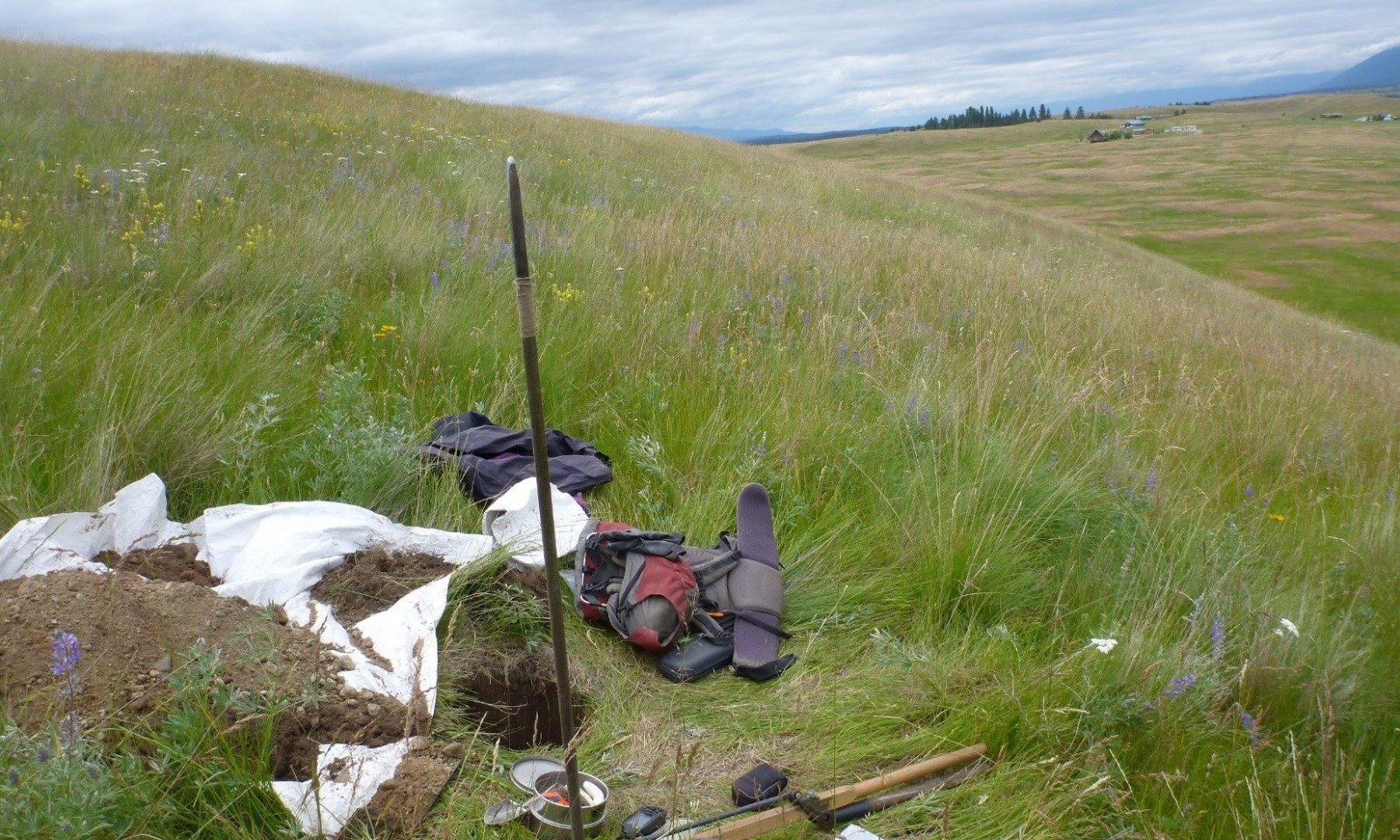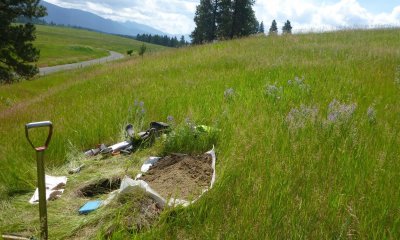
Loamy Steep Seeley, Swan, Flathead and Tobacco Valleys
Scenario model
Current ecosystem state
Select a state
Management practices/drivers
Select a transition or restoration pathway
-
Transition T1A
Overgrazing, Soil Erosion
More details -
Transition T1B
Introduction of Weedy Propagules, Overgrazing
More details -
Transition T1C
Introduction of weedy seed propagules, establishment of weedy species and resultant dominance of weed species to native plant species.
More details -
Restoration pathway R2A
Mechanical Brush Management, Range Seeding
More details -
Transition T2A
Introduction of Weedy Propagules, Fire
More details -
Transition T2B
Introduction of Weedy Propagules
More details -
Restoration pathway R3A
Proper Grazing Management, Range
More details - Restoration pathway R3B More details
-
Transition T3A
Introduction of Weedy Propagules
More details -
Restoration pathway R4A
Weed Management, Range Seeding
More details -
Restoration pathway R4B
Weed Management, Woody Propagules
More details -
Restoration pathway R4C
Weed Management, Wood Propagules Not Present
More details -
No transition or restoration pathway between the selected states has been described
Target ecosystem state
Select a state
State 1
Reference State - Taller Bunchgrass State



Description
This state is characterized by cool-season bunchgrasses and is represented by three communities that differ mainly in the percent composition rough fescue and Idaho fescue (Festuca idahoensis) and bluebunch wheatgrass and presence of shrub species.
Submodel
Description
This state is characterized by having < 10% rough fescue and < 50% canopy cover. State 2 is represented by two communities that differ in the percent composition of Idaho fescue, production, and soil degradation. Production in this state is considerably lower than in the Taller Bunchgrass State (1). Some native plants tend to increase under prolonged drought and/or heavy grazing practices. A few of these species include Idaho fescue, needleandthread, Sandberg bluegrass, silky lupine, field chickweed, ballhead sandwort, common snowberry, Wood’s rose and fringed sagewort.
Submodel
Description
Community Phase Narrative:
Long-term grazing mismanagement with continuous growing-season pressure will reduce total productivity of the site and lead to an increase of bare ground. Once plant cover is reduced, the site is more susceptible to erosion. Soil erosion reduces soil fertility creating a reduction in plant production. This soil erosion or loss of soil fertility indicates the transition to the Sparsely Vegetated State (3). The decline may be exacerbated by extended drought conditions.
Very sparse plant cover and soil surface erosion characterize this community. Grass and forb, and shrub cover may be very sparse or clumped (canopy cover less than 25 percent). Weeds, annual species, or shortgrass species dominate the plant community. Mid-stature perennial bunchgrass species (e.g., needleandthread) may exist, but only in patches.
Compared to the Taller Bunchgrass State (1) and the Altered State (2), this community has crossed a threshold (T1B, T2A) because of soil erosion, loss of soil fertility, or degradation of soil properties. If further soil erosion occurs, there will be a critical negative shift in the ecological processes of this site. The affects of soil erosion can alter the hydrology, soil chemistry, soil microorganisms, and soil physics to the point where intensive restoration is required to restore the site to another state or community. Simply changing grazing management cannot create sufficient change to restore the site within a reasonable period. It will require a considerable input of energy to move the site back to the Taller Bunchgrass State (1). This state has lost soil or vegetation attributes to the point that recovery to the Taller Bunchgrass State (1) will require reclamation efforts, i.e., soil rebuilding, intensive mechanical treatments, and/or reseeding.
In this community phase there may be a significant amount of bare ground, and large gaps may occur between plants. The transition to this state could occur because of overgrazing (often because of failure to adjust stocking rates in response to declining forage production because of increased dominance of unpalatable invasive species), long-term lack of fire, warming climate, or extensive drought. Potential exists for soils to erode to the point that irreversible damage may occur. If herbaceous cover decreases to the point that soils are no longer stable, the shrub overstory may not prevent soil erosion.
This plant community may be in a terminal state that will not return to the reference state because of degraded soil properties and loss of higher successional native plant species.
Submodel
Description
The Invaded State (4) is characterized by greater than 25 percent of invasive species: spotted knapweed, leafy spurge, sulphur cinquefoil, and/or cheatgrass are the dominant invasive species in MLRA 44A. Introduced exotic plant species have been identified as one of the greatest threats to the integrity and productivity of native rangeland ecosystems and conservation of indigenous biodiversity (DiTomaso 2000; Mack et al. 2000). In addition to environmental consequences, damages caused and costs incurred to control invasive plants are several billion dollars each year in the United States (Pimentel et al. 2000).
Submodel
Mechanism
Transition T1A
The Taller Bunchgrass State (1) transitions to the Altered State (2) if rough fescue falls below 10 percent species composition. The trigger for this transition is the loss of taller bunchgrasses, which creates a shift in species composition towards lower productive species, especially Idaho fescue. This transition can occur from any community within the Taller Bunchgrass State (1), it is not dependent on an increase of woody canopy cover, but on the decrease of rough fescue production. The driver for this transition is improper grazing management and/or long-term drought leading to a decrease in rough fescue composition to less than 10 percent.
Mechanism
Transition T1B
The Taller Bunchgrass State (1) transitions to the Sparsely Vegetated State (3) if plant canopy cover declines to less than 25 percent or and rough fescue decreases to below 10 percent by dry weight. The trigger for this transition is the loss of taller bunchgrasses, which creates open spots of bare soil. Soil erosion is accompanied by decreased soil fertility driving the transitions to the Sparsely Vegetated State. There are several other key factors signaling the approach of transition T1B: increases in soil physical crusting, decreases in cover of cryptogamic crusts, decreases in soil surface aggregate stability and/or evidence of erosion including water flow patterns, development of plant pedestals, and litter movement. The driver for this transition is improper grazing management and/or long-term drought leading to a decrease in rough fescue composition to less than 10 percent.
Mechanism
Transition T1C
Regardless of grazing management, without some form of weed management (chemical, mechanical, or biological control), the Taller Bunchgrass State (1) can transition to the Invaded State (4) if aggressive invasive species, such as spotted knapweed and cheatgrass are introduced, even if the herbaceous component of the Reference Plant Community (1.1) is thriving. Healthy plant communities are most resilient to invasives. Long-term stress conditions for native species (e.g., overgrazing, drought, and fire) accelerate the process. If populations of invasive species reach critical levels, the site transitions to the Invaded State. The driver for this transition is the presence of aggressive invasive species.
Mechanism
Restoration Pathway R2A
Restoration of the Altered State to the Taller Bunchgrass State requires substantial energy input. The drivers for this restoration pathway are removal of woody species, restoration of native herbaceous species by reseeding rough fescue.
Mechanism
Transition T2A
Removal of shrubs without proper grazing management can lead to an increase in bare ground and erosion of the fertile surface horizon and the site can degrade to the Sparsely Vegetated State (3). The driver for this transition is brush management without proper grazing management.
Mechanism
Transition T2B
Removal of shrubs can lead to an increase in bare ground. If invasive species are present, bare ground offers opportunity for invasive species to fill open areas, leading to the Invaded State (4). The driver for this transition is brush management in presence of invasive species.
Mechanism
Restoration Pathway R3A
The Sparsely Vegetated State (3) has lost soil or vegetation attributes to the point that recovery to the Taller Bunchgrass State (1) will require reclamation efforts such as soil rebuilding, intensive mechanical treatments, and/or revegetation. The drivers for this restoration pathway are reclamation efforts and proper grazing management. The trigger is restoration efforts.
Mechanism
Restoration Pathway R3B
The Sparsely Vegetated State (3) has lost soil or vegetation attributes to the point that recovery to the Altered State (2) will require reclamation efforts such as soil rebuilding, intensive mechanical treatments, and/or reseeding in recommended areas only. If the reclamation efforts are performed without reseeding rough fescue, under unfavorable climatic conditions, or without proper grazing management, the site will return to the Altered State.
Mechanism
Transition T3A
Invasive species can occupy the Sparsely Vegetated State (3) and drive it to the Invaded State (4). The Sparsely Vegetated State is at risk of this transition occurring if invasive propagules are present. The driver for this transition is the presence of critical population levels (greater than 25 percent) of invasive species. The trigger is the presence of propagules of invasive species.
Mechanism
Restoration Pathway R4A
Restoration of the Invaded State (4) to the Taller Bunchgrass State (1) requires substantial energy input. The drivers for this restoration pathway are removal of invasive species, restoration of native bunchgrass species, ongoing management of invasives, and proper grazing management. Without maintenance, invasive species are likely to return (probably rapidly) because of the presence of propagules in the soil and increases in soil disturbance. The drivers for this reclamation pathway are treatments to reduce or remove invasive/noxious species in combination with favorable growing conditions. The trigger is invasive species control.
Mechanism
Restoration Pathway R4B
Weed management without reseeding taller bunchgrasses, favorable climatic conditions, or proper grazing management will lead to the Altered State (2).
Mechanism
Restoration Pathway R4C
If invasive species are removed without sufficient remnant populations of reference community species (particularly rough fescue), a site in the Invaded State (4) is likely to return to the Sparsely Vegetated State (3) instead of the Taller Bunchgrass State (1). The driver for the reclamation pathway is weed management without reseeding. The trigger is invasive species control.
Model keys
Briefcase
Add ecological sites and Major Land Resource Areas to your briefcase by clicking on the briefcase (![]() ) icon wherever it occurs. Drag and drop items to reorder. Cookies are used to store briefcase items between browsing sessions. Because of this, the number of items that can be added to your briefcase is limited, and briefcase items added on one device and browser cannot be accessed from another device or browser. Users who do not wish to place cookies on their devices should not use the briefcase tool. Briefcase cookies serve no other purpose than described here and are deleted whenever browsing history is cleared.
) icon wherever it occurs. Drag and drop items to reorder. Cookies are used to store briefcase items between browsing sessions. Because of this, the number of items that can be added to your briefcase is limited, and briefcase items added on one device and browser cannot be accessed from another device or browser. Users who do not wish to place cookies on their devices should not use the briefcase tool. Briefcase cookies serve no other purpose than described here and are deleted whenever browsing history is cleared.
Ecological sites
Major Land Resource Areas
The Ecosystem Dynamics Interpretive Tool is an information system framework developed by the USDA-ARS Jornada Experimental Range, USDA Natural Resources Conservation Service, and New Mexico State University.


